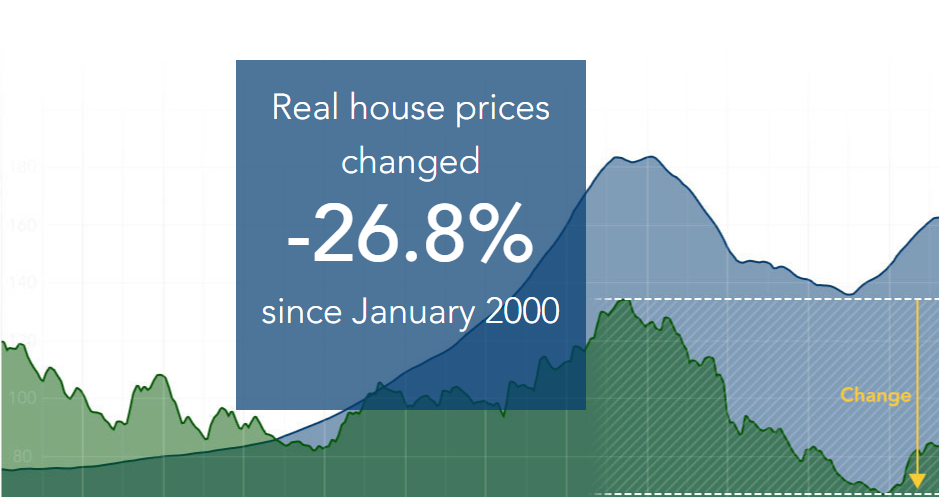First American Financial Corporation [1] released the February 2023 First American Real House Price Index (RHPI) [2], measuring housing affordability and the price changes of single-family properties throughout the U.S.
“Affordability has now improved for four straight months, yet remains down 32% since February 2022, according to the RHPI," Mark Fleming, Chief Economist at First American. "Recently falling mortgage rates have overpowered the affordability-dampening effects of higher nominal house prices. Nominal house price appreciation has slowed dramatically in response to affordability-constrained lower demand. After peaking in March 2022 at 21% nationally, annual nominal house price growth has since decelerated by 18 percentage points to 3.1% in February."
February 2023 Real House Price Index Highlights
- Real house prices decreased 0.2% between January 2023 and February 2023.
- Real house prices increased 31.6% between February 2022 and February 2023.
- Consumer house-buying power, how much one can buy based on changes in income and interest rates, increased 0.5% between January 2023 and February 2023, and decreased 21.7% year-over-year.
- Median household income has increased 4.1% since January 2022 and 80.8% since January 2000.
- Real house prices are 33.3% more expensive than in January 2000.
- Unadjusted house prices are now 50% above the housing boom peak in 2006, while real, house-buying power-adjusted house prices are 6.5% below their 2006 housing boom peak.
“Real estate is local, and house prices are down from their peaks in 37 of the top 50 markets," said Fleming. "With house prices declining, some are concerned about the rising risk of a wave of foreclosures. Yet, foreclosures are the result of two triggers: economic hardship and lack of equity.” [3]
[3]
The Dual Triggers Necessary for Foreclosure
“Foreclosure is a two-step process. First, the homeowner suffers an adverse economic shock, such as a loss of income, serious illness, or the death of a spouse, leading to the homeowner becoming delinquent on their mortgage,” said Fleming. “However, not every delinquency turns into a foreclosure. With enough equity, a homeowner has the option of selling the home.
Fleming continued: "The reverse is also true. If the homeowner has little equity in their home, but suffers no financial setback that leads to delinquency, there is no need for a foreclosure. This is what we call the ‘dual-trigger hypothesis.' Economic hardship or a lack of equity are alone insufficient to trigger a foreclosure. Only when both conditions exist does foreclosure become a likely outcome.”
February 2023 Real House Price State Highlights
The five states with the greatest year-over-year increase in the RHPI are:
- Maryland (+41.3%)
- Nebraska (+40.0%)
- Alabama (+39.7%)
- Iowa (+39.6%)
- Florida (+39.5%)
Equity Levels Remain High
“While nominal house prices are declining across many of the top 50 markets, there is one trend that bodes well for homeowners in all markets – much of the equity gained during the pandemic remains," said Fleming. "For example, San Jose, Calif. has experienced the most severe price declines from the peak, yet house prices remain 14% above their pre-pandemic level. As the housing market rebalances, price declines will continue across many markets, but those declines would have to be substantial to erase all of the equity gains accumulated by homeowners during the pandemic boom. Additionally, inventory remains historically low in many top markets, putting a floor on how low house prices can fall. The risk of the equity trigger for foreclosure is low.”
There were no states with a year-over-year decrease in the RHPI.
Unemployment Still Below Pre-Pandemic Averages
“While low compared with pre-pandemic levels, rising economic distress and the end of the foreclosure moratorium in 2021 have caused economic hardship for some, especially those homeowners directly impacted by the pandemic,” said Fleming. “Foreclosures have increased from near zero, but remain well below pre-pandemic levels. Nonetheless, unemployment rates across the top 50 markets remain low.
February 2023 Real House Price Local Market Highlights
Among the Core Based Statistical Areas (CBSAs) tracked by First American, the five markets with the greatest year-over-year increase in the RHPI are:
- Miami (+50.0%)
- Indianapolis (+45.3%)
- Jacksonville, Fla. (+42.5%)
- Baltimore (+40.1%)
- Louisville, Ky. (+40.1%)
Among the Core Based Statistical Areas (CBSAs) tracked by First American, there were no markets with a year-over-year decrease in the RHPI.
“Las Vegas had the highest unemployment rate (6.0%) in February 2023, but still has a lower unemployment rate than its pre-pandemic historic average. Additionally, even as the Las Vegas unemployment rate sits above other top markets, house prices in Las Vegas are up 36% compared with pre-pandemic levels,” said Fleming. “All 49 other top markets had an unemployment rate below 5%, which is lower than the pre-pandemic national historical average of 5.8%. So far, layoffs have not been broad based, and the protection that equity provides to those that have experienced economic hardship has helped to keep foreclosures from rising faster.”
Is a Foreclosure Tsunami On the Way or Just a Trickle?
“Economic distress and a lack of equity are the two triggers of a foreclosure," said Fleming. "Alone, each trigger is necessary, but not sufficient to trigger a foreclosure. The equity acquired since the start of the pandemic can provide an important buffer for distressed homeowners. Additionally, while the labor market is showing some early signs of slowing and economic distress is increasing, unemployment rates remain low across the top 50 markets. A softening labor market combined with declining house prices may ultimately increase foreclosures, but the increase is more likely to be a trickle than a tsunami.”
Next Release
The next release of the First American Real House Price Index will take place the week of May 29, for March 2023 data.
To read the full report, including more data, charts and methodology, click here [4].
